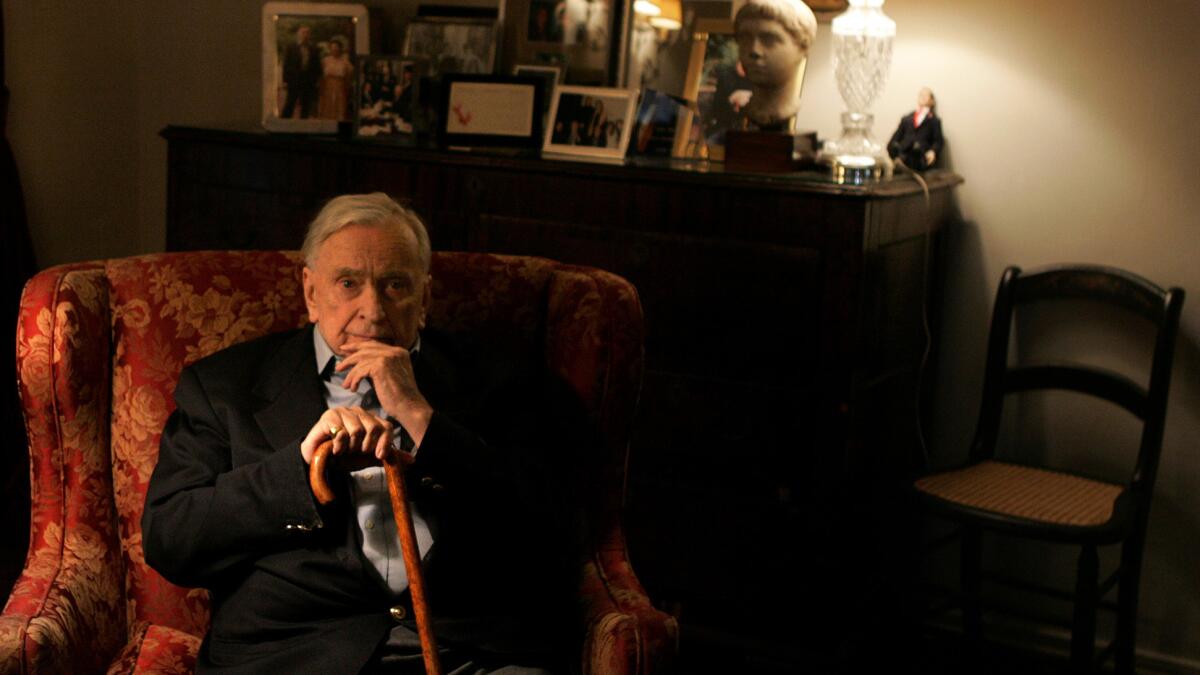Saluting ‘Myra Breckinridge’ on its 50th anniversary
- Share via
It’s tempting to leave “Myra Breckinridge” well enough alone.
Compared to the rest of his oeuvre, Gore Vidal’s 1968 novel seems misbegotten, like racing stripes on a limousine. His reputation was built on tart criticism and erudite, patrician historical novels about Washington, D.C., not a comic romp about a transgender woman hellbent on using L.A. as a launchpad for world domination. “Myra Breckinridge” alienated and befuddled critics at the time, and some of its glib posturing about overpopulation and consent hasn’t aged well. And then there’s the 1970 film version, which remains one of Hollywood’s most notorious debacles, delivering late-career humiliations to John Huston and Mae West in a story that wasn’t so much plotted as disgorged onto film. The book is remembered, if at all now, as farcical and unserious.
And yet! (The narrator’s exclamatory tone has a way of sticking with you.) “Myra Breckinridge” was a national sensation at the time, selling more than 2 million copies.
Moreover, its provocations gave it a key role in a series of televised debates between Vidal and William F. Buckley during the 1968 presidential nomination conventions — dogfights that were themselves proxy battles over the liberal frustrations with a seemingly endless war and conservative demands for “law and order.”
Sound familiar? Myra is an intrepid observer of the socio-politico-gendered condition, and 50 years ago she sounded an alarm about the threat hypermasculinity posed to the nation. Young men, she observes, are “quite totalitarian-minded, even for Americans, and I am convinced that any attractive television personality who wanted to become our dictator would have their full support.”
In that light, “Myra” speaks to our present condition with a rare nerviness, humor and brio. Reading “Myra Breckinridge” in 2018 is a reminder that in many ways America’s conversations about sex, power and celebrity — and the resistance to those conversations — have stubbornly persisted for 50 years.
By his own account, Vidal wrote the book as little more than a lark. Its predecessor, 1967’s “Washington, D.C.,” the first in his acclaimed run of historical novels, took nearly a decade to complete. By contrast, he churned out “Myra Breckinridge” in a matter of weeks while living in Rome. He’d been contemplating a few of the novel’s themes in essays for years — film versus television, the future of the novel, overpopulation, gender politics. People in certain circles knew Vidal was gay — his 1948 novel, “The City and the Pillar,” was a pathbreaking LGBT novel. But even until his death in 2012 he avoided discussing his sexuality publicly. So he entered the late ’60s bearing a complex stew of attitudes and emotions, which inevitably shaped “Myra Breckinridge.” The novel delivers the palpable, giddy sensation of a writer privately allowing himself to heedlessly set loose his id.
“I am Myra Breckinridge whom no man will ever possess,” the novel opens, and it never stops being Vidal’s fever dream about a woman’s quest for dominance. Myra, claiming to be the widow of a film critic named Myron Breckinridge, installs herself in the Chateau Marmont scheming for property: Myron’s uncle, Buck Loner, owns a Westwood acting school, and Myron’s will entitles her to half its land. While Buck, a retired star of cowboy films, sics his lawyers on her claim (it’s ultimately revealed that Myra was Myron), Myra insinuates herself into the student body.
“My mission: the destruction of the last vestigial traces of traditional manhood in the race in order to realign the sexes, thus reducing population while increasing human happiness and preparing for its next stage,” she writes. Myra’s goal is patently delusional — how do you reweave the fabric of society from a failing theater school outside Hollywood? But we’re also meant to see the justness of her motivations to upend our notions of sexual dominance. Admiring the lusty agent Leticia Van Allen, she quips: “How can you shock me when you are just like me? The new American woman who uses men the way they once used women.”
I am convinced that any attractive television personality who wanted to become our dictator would have [young men’s] full support.
— Gore Vidal’s ‘Myra Breckinridge’
Myra has a funny way of making the case for gender equality, though. Training her gaze on Rusty, an All-American and none-too-bright slab of beefcake, she manipulates and then rapes him. We’re meant to read the scene and its aftermath as a major step in her grand social ledger-balancing. “I was reducing his status from man to boy to child to — ah, the triumph!” she proclaims. It’s an unsettling scene, its cynicism par for the course for Vidal, who was inclined to think of America as forever courting decline. (Washington’s monuments would make “beautiful ruins,” he’d famously said.) Any hope of the country righting itself would demand a wholesale reshuffling of the sexual order. “Let us break the world’s pots,” Myra writes, “and allow the stuff of desire to flow and intermingle in one great viscous sea.” If it took a rape scene to shake America out of its rut of heteronormative desires and power plays, Vidal figured, so be it.
Vidal dedicated the novel to gay novelist Christopher Isherwood. “A very subtle psychological self-portrait,” he wrote in a letter to Vidal after reading the manuscript, tongue firmly in cheek. Buoyed by its sensationalistic premise, the novel was a hit, selling out of three printings even before its publication date of Feb. 29, 1968. Reviewers revolted — “has literary decency fallen so low?” asked Time — but Vidal knew they would and made an end run around them, refusing to send advance copies to what he called “the silly-billies of book-chat land.”
Indeed, the novel’s best-known critic wasn’t a reviewer but a pundit: The National Review’s William F. Buckley seized on “Myra Breckinridge” as an exemplar of the perceived collapsing morals of the left, offering “gratification only to sadist homosexuals and challenge only the taxonomists of perversion.” The novel became a recurring touch point during their debates, which aired nightly on ABC after the closing of the Miami and Chicago conventions. On Aug. 28, tensions overflowed between the two, and Buckley lashed out, outing Vidal on live TV: “Listen, you queer, stop calling me a crypto-Nazi or I’ll sock you in the goddamn face, and you’ll stay plastered,” he fumed. “Now go back to your pornography.”
Retorts were exchanged; lawsuits were filed and settled. But what’s interesting now isn’t so much the squabble as the intensity of the backlash. It is striking how a comic novel, dashed off in a few weeks and more provocative than pornographic, set a culture aflame for proposing a radical equality of the sexes. Vidal would return to the theme again in 1974’s “Myron,” in which Myron and Myra’s psyches do battle on a ’40s Hollywood set. It’s a goofball and labored sequel, but its animating spirit remained the same. Once again, a woman is trying to be kept down; once again, she won’t be suppressed. “Myra lives!” are its last words. She deserves to, but now, she can only be found at used booksellers. “Myra Breckinridge” is out of print.
Athitakis is a writer and critic based in Phoenix.

More to Read
Sign up for our Book Club newsletter
Get the latest news, events and more from the Los Angeles Times Book Club, and help us get L.A. reading and talking.
You may occasionally receive promotional content from the Los Angeles Times.







